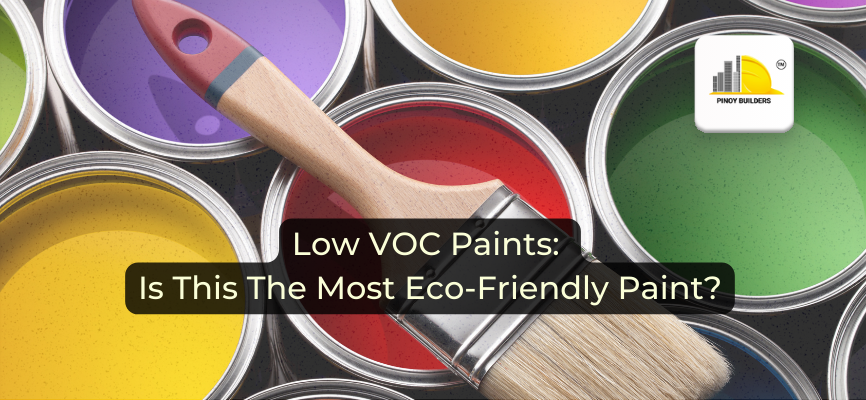Painting is an important part of building a structure. The paints used in this process are commonly used to color, provide texture, or protect the surface it is painted on. But did you know that most paints are made with chemicals that can leave a negative environmental impact? Fortunately, paint manufacturers came up with a more environment-friendly solution in the form of Low VOC Paints.
But what are low-VOC paints?
Low-VOC paints are paints that contain less volatile organic compounds (VOC) than traditional paints.
VOCs are chemicals found in solvent-based paints and some water-based paints. The purpose of VOCs in these paints and coatings include:
• Acting as a medium to transfer the paint from the can to the surface
• Aids in the paint’s flow
• Slows the initial drying to give more time to work with the paint
• Preserves the paint and protects it from spoiling
• Some rust-preventing paints need VOCs
Aside from paints, VOCs can also be found in paint thinners and brush cleaners.
Why are VOCs an issue?
VOCs are air pollutants. Once applied on a surface, the VOCs will evaporate and negatively affect indoor and outdoor air quality, causes negative health effects, and have a negative environmental impact.
VOC paints contain harmful chemicals such as formaldehyde, benzene, and toluene which can emit toxic fumes into the air during and after application. This emission can last for weeks, months, or even years. Due to the release of these chemicals, indoor air quality will be reduced and it will also contribute to the formation of ground-level ozone, a major component of smog.
The ground-level ozone it releases has a significant negative impact on the environment. Since it contributes to smog formation, it can harm plants, and animals, and can cause damage to buildings and materials. Furthermore, the production of VOC paints uses energy and non-renewable resources and the disposal of leftover paint creates hazardous waste.
When it comes to health, VOC paints increase the risk of health problems such as headaches, eye irritation, dizziness, nausea, respiratory conditions, central nervous system damage, organ damage, and other serious health issues.
Are Low VOC Paints Eco-Friendly?
Compared to traditional paints, low VOC paints generally have fewer toxic chemicals and emit lower levels of toxic fumes in the air. This makes them a safer and healthier option for both people and the environment.
In addition, many low-VOC paints are manufactured using eco-friendly materials and processes. Most VOC paints are water-based which makes them less harmful to the environment. Natural pigments such as clay, mineral-based pigments, and plant-based dyes are used instead of synthetic dyes which makes them more sustainable. Some low-VOC paints also use recyclable materials in products such as plastic or paper which helps in reducing waste and conserving resources. Instead of using synthetic binders, some low VOC paints use plant-based binders, such as soy or linseed oil which are renewable and biodegradable. Also, some low-VOC paints use less harmful natural thickeners and stabilizers to improve their performance.
While they still contain small amounts of VOCs, they still have a smaller negative impact on the environment and human health.
Some of the low VOC paints available in the Philippine Market include:
• Boysen Healthy Home Odor-less Antibacterial Latex Paint
• Boysen Knoxout Air Cleaning Paint
• Davies Bio-Fresh
• Odour Fresh Premium Odour-less Anti-Bacterial Latex Paint
• Nippon Paint Odour-less AirCare
• Benjamin Moore Eco Spec
Conclusion
Paints are an important material for construction because it gives surfaces pleasing aesthetics and protection. While most paints contain harmful chemicals, low VOC paints open possibilities for sustainability. Low-VOC paints are not only eco-friendly and sustainable, but it is also less harmful to human health.
References:
- Flanagan, L. (2022, November 21). VOC Paint vs No-VOC Paint Comparison Guide. The Spruce. https://www.thespruce.com/low-voc-paint-and-no-voc-paint-1976533#toc-environmental-impact
- Low VOC paints | Dulux. (n.d.). https://www.dulux.com.au/applicator/technical-advice/application/low-voc-paints
- Technical Overview of Volatile Organic Compounds | US EPA. (2023, March 14). US EPA. https://www.epa.gov/indoor-air-quality-iaq/technical-overview-volatile-organic-compounds#conclusion
- American Lung Association. (n.d.). Volatile Organic Compounds. https://www.lung.org/clean-air/at-home/indoor-air-pollutants/volatile-organic-compounds#:~:text=Breathing%20VOCs%20can%20irritate%20the,Some%20VOCs%20can%20cause%20cancer.








